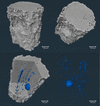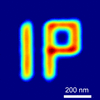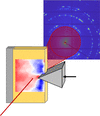issue contents
September 2024 issue

Cover illustration: A 3D-printed in situ/operando cell has been designed and used for X-ray absorption spectroscopy studies during the synthesis of Pd/TiO2 photocatalyst and its operation for hydrogen evolution reaction (see Kozyr, Martí-Sánchez, Skorynina, Arbiol, Escudero, Mino and Bugaev, pages 1071–1077). Owing to the specific cell design, the obtained Pd nanoparticles exhibit much narrower and uniform particle size distribution compared with those obtained in batch reactors.
facility information
PhotonMEADOW2023 workshop
Open  access
access
 access
accessA neural network trained with a few thousand simulations using random errors is demonstrated to predict accurately the lens error profile that accounts for all aberrations of a compound refractive lens in a synchrotron beamline.
Open  access
access
 access
accessSingle-shot damage of an 200 nm-thick Au thin film is experimentally studied with a UV FEL of 121.6 nm wavelength and 2 ps pulse length. The characterized, as well as visually observed, phenomena are analyzed with multiple theoretical approaches.
Open  access
access
 access
accessAn X-ray ionization beam position monitor developed for PAL-XFEL soft X-rays is introduced.
Open  access
access
 access
accessDiamond sensors have been developed and tested for operation with high-energy X-ray beams at the European XFEL.
Open  access
access
 access
accessSpexwavepy: an open-source Python package for X-ray wavefront sensing using speckle-based techniques
An open-source Python package for X-ray wavefront sensing using speckle-based techniques, namely spexwavepy, has been presented.
Open  access
access
 access
accessMLgrating, a MATLAB program for simulating multilayer grating efficiencies, is presented.
Open  access
access
 access
accessA state-of-the-art multilayer deposition system has been developed at Diamond Light Source; this instrument is engineered to produce single and multilayer coatings, accommodating mirrors up to 2000 mm in length through the utilization of eight rectangular cathodes.
Open  access
access
 access
accessBy utilizing the active Kirkpatrick–Baez optical system in collimation mode coupled with a spiral zone plate, orbital angular momentum (OAM) beams have been successfully generated and characterized. The reported findings are relevant for future experiments on OAM structured beams.
Open  access
access
 access
accessThe damage threshold fluences of silicon (Si) and boron carbide (B4C)-coated Si at 1 keV and 9 mrad grazing incident angle are compared. Results show that B4C has a damage threshold approximately twice that of Si, highlighting the advantages of using B4C coatings for enhanced durability.
X-ray spectroscopy for functional materials
Open  access
access
 access
accessAn in situ approach to generate photocatalysts using a custom-made photocatalytic cell allowed, by synchrotron-based X-ray absorption spectroscopy, the different stages of Pd nucleation onto TiO2 samples to be followed yielding a highly homogeneous distribution of 1 nm palladium nanoparticles.
Open  access
access
 access
accessAb initio molecular dynamics has been used to study the structure of a WSe2 multilayer deposited on silicon.
Open  access
access
 access
accessFull-field hyperspectral X-ray absorption spectroscopy imaging implemented at a quick-EXAFS beamline offers the capability to add micrometre-scale information to second time resolution for operando monitoring of functional materials under process conditions.
Open  access
access
 access
accessThe RefXAS database under DAPHNE4NFDI enables users to access quality-controlled, curated X-ray absorption spectra of references along with important metadata and to share their data with the research community in easy steps.
Open  access
access
 access
accessNormalization of XANES data to the spectral area is shown to be a viable normalization method with an error of a few percent as evaluated by comparison with calculated spectra and spectra normalized to the edge-jump.
research papers
Open  access
access
 access
accessActive damping with internal absolute velocity feedback was implemented to damp the angular vibration of a mirror holder for free-electron laser beam transportation.
Open  access
access
 access
accessThe polarization capabilities of SwissFEL's Athos beamline are demonstrated by deriving the Stokes parameters as a function of the undulator phase and comparing them with experimental measurements obtained by cold target recoil ion momentum spectroscopy.
Open  access
access
 access
accessAn innovative double-edge scan wavefront metrology method has been developed which can resolve the problem of high-precision crystal absolute diffraction wavefront measurements. This method can be regarded as a critical feedback mechanism in the processing of next-generation crystals.
Open  access
access
 access
accessA high-performance in-vacuum undulator has been developed in a cost-effective manner.
Open  access
access
 access
accessThe linear shape control and actuation of a modeled adaptive X-ray optic in a cantilever geometry is described, showing that control is mathematically similar to that of the more common mounting approaches.
Open  access
access
 access
accessA set-up for two-color experiments at FLASH2 utilizing the split-and-delay unit at FL23 and FL24 is presented. It will be achieved by using suitable filters and an additional grating beam path with a dispersion compensated monochromator.
Open  access
access
 access
accessA new material for substrates of optical elements used under ultra-powerful X-ray beams is described – the diamond-silicon carbide composite Skeleton®. The composition and structure of the material, its surface roughness with a technological coating of polycrystalline silicon and its thermophysical characteristics are studied.
Open  access
access
 access
accessThe synchrotron radiation beam from the Circular Electron–Positron Collider (CEPC) in China can be considered as one of the best beams for FLASH radiotherapy after using a physicochemical model to predict the macroscopic therapeutic effect.
Open  access
access
 access
accessA novel method for transmission intensity measurement and scattering intensity normalization is developed. This method enables true synchronization of scattering and transmission signal measurements, and separation of the transmission intensity of fundamental radiation from the attenuated direct beam.
Open  access
access
 access
accessA full description of the TEMPUS system for photon science is given. The detector takes advantage of the new Timepix4 readout chip and, in particular, implements the use of the time-stamping mode for high-resolution timing applications.
Open  access
access
 access
accessThe characterization of electron-collecting CdTe for use in a 77 ns burst-rate charge-integrating detector is described.
Open  access
access
 access
accessThis study introduces an optimized indirect X-ray microscope capable of achieving micrometre pixel size and megahertz acquisition speed, leveraging enhanced sensitivity in the near-ultraviolet spectrum and single-crystal fast-decay scintillators. This development enables high-resolution imaging for dynamic phenomena, exemplified by experiments with pulsed wire explosion and superheated near-nozzle gasoline injection.
Open  access
access
 access
accessThe development of hard X-ray nanoprobe techniques has given rise to a number of experimental methods, like nano-XAS, nano-XRD, nano-XRF, ptychography and tomography. Each method has its own unique data processing algorithms. With the increase in data acquisition rate, the large amount of generated data is now a big challenge to these algorithms. Here, software is proposed that is based on distributed systems with an intuitive graphical user interface design that allows users to easily operate and configure the software.
Open  access
access
 access
accessA new three-electrode battery cell designed for synchrotron techniques, allowing operation in both transmission and reflection geometry, has been tested and demonstrated.
Open  access
access
 access
accessStreamSAXS has been developed as a Python-based desktop application within the SAXS/WAXS analysis system. It features a plug-in framework and seamless integration into large-scale acquisition systems for full-lifecycle data management.
Open  access
access
 access
accessThe differentially pumped gas filter of the VUV beamline at the SLS is adapted to record VUV absorption spectra of gaseous samples over a broad photon energy range. Water and nitrous oxide spectra are recorded in proof-of-principle measurements.
Open  access
access
 access
accessA 1D imaging soft X-ray spectrometer, installed and commissioned on the SQS instrument of the European XFEL, is described.
Open  access
access
 access
accessWeb-CONEXS is introduced – a web application hosted on ISPyB at Diamond Light Source, which provides a platform for modelling XAS spectra based on minimal user input.
Open  access
access
 access
accessOur work presents recent advancements in 3D-printed nozzles for liquid jet spectroscopy, made possible by the availability of nozzle development and testing facilities at EuXFEL, Germany. We also demonstrate the performance of one of these custom-designed nozzles in a new flat jet system under commissioning at MAX IV Laboratory in Lund, Sweden, introducing a new injection method to analyze flat liquid surfaces and opening new possibilities for the spectroscopy community.
Open  access
access
 access
accessX-ray phase-contrast microtomography is demonstrated using two-dimensional amplitude modulation of the beam. The implementation is characterised in terms of angular sensitivity and spatial resolution, and its application to the three-dimensional imaging of biological soft tissues is shown.
Open  access
access
 access
accessThe opportunities for time-resolved X-ray imaging at diffraction-limited storage rings are demonstrated by benchmarking time-resolved 2D and 3D imaging at ForMAX, MAX IV. The enhanced flux density provided by the MAX IV storage ring allows micrometer-resolution time-resolved imaging at 2 kHz and 1.1 MHz acquisition rates in 3D and 2D, respectively.
Open  access
access
 access
accessAn algorithm has been developed that effectively corrects and tracks angular distortions, enabling BCDI to work much more robustly and accurately in a wider range of challenging experimental scenarios.
Open  access
access
 access
accessScientific computing augmentation paving the way for the advent of next-generation synchrotron imaging research is discussed.
Open  access
access
 access
accessUsing a novel acquisition scheme for SAXS tensor tomography to obtain complete data for a millimeter-sized sample of human trabecular bone, we investigate and quantify the impact of the missing wedge problem on the reconstruction across real and reciprocal space.
short communications
Open  access
access
 access
accessAmbiguity, which is an intrinsic characteristic of coherent diffraction imaging during image retrieval, can be reduced using machine learning.
beamlines
Open  access
access
 access
accessThe current state of the Biomedical Imaging and Therapy beamlines of the Canadian Light Source is described and new capabilities are presented.
Open  access
access
 access
accessThe recently inaugurated beamline ID10-BEATS for hard X-ray full-field tomography at the SESAME synchrotron in Jordan is presented. The design, performance and scientific applications of the beamline, which was developed within the European Horizon 2020 project BEAmline for Tomography at SESAME, are illustrated.
Open  access
access
 access
accessA high-energy-resolution X-ray spectrometer has been commissioned at the SXFEL Facility, delivering single-shot resolving power beyond 20000 to provide support for fine-tuning and optimization of the machine, during scientific research. The fine structure of the individual spiky peak in the SASE spectrum is clearly resolved to characterize the pulse length of FEL radiation.
Open  access
access
 access
accessA new mobile sample-delivery system dedicated to in-flight studies of pristine aerosols and unsupported nanoparticles using X-ray photoelectron spectroscopy at the MAX IV Laboratory in Lund, Sweden, is presented. The aerosol sample-delivery system brings an aerosol from atmospheric pressure to the experimental chamber in a continuous flow, and the design, operation and commissioning results of the system are presented.
Open  access
access
 access
accessThe upgrade of beamline BL08U1A at SSRF has been recently conducted. The energy range is 180–2050 eV, the energy resolution can reach up to 16333 @ 244 eV and 12730 @ 401 eV, and the photon flux measured in the experimental station is over 2.45 × 109 photons s−1 (E/ΔE = 6440 @ 244 eV).
computer programs
Open  access
access
 access
accessMuscleX is an integrated, open-source computer software suite for data reduction of X-ray fiber diffraction patterns from striated muscle as well as other fibrous systems.
addenda and errata
Open  access
access
 access
accessErrors in variable subscripts, equations and Fig. 8 in Section 3.2 of the article by Lotze et al. [(2024). J. Synchrotron Rad. 31, 42–52] are corrected.

 journal menu
journal menu


































































